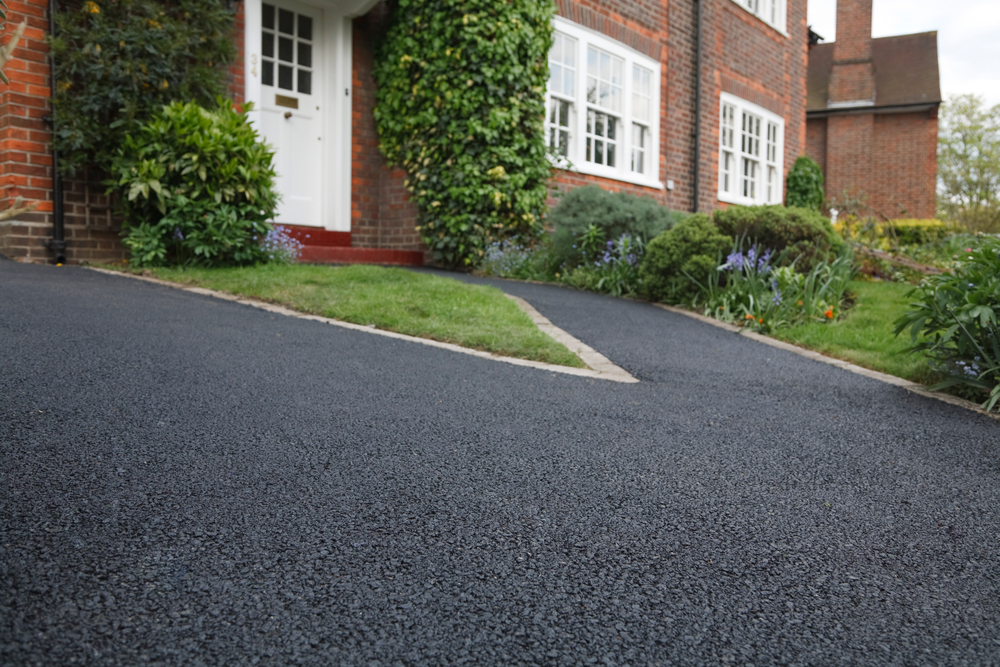Asphalt is an incredibly practical driveway material, and fortunately requires minimal maintenance. That said, there are some crucial steps to caring for your asphalt driveway. By carrying out these steps you’ll ensure that your driveway is safe, sound, looks great and has the longest lifespan possible.
Here’s what all homeowners should know about how to care for an asphalt driveway…
Regularly Inspect the Driveway for Issues
Contents

Arguably the most important step in caring for an asphalt driveway is simply keeping an eye on it. Any issues that appear are cheaper and easier to solve if spotted quickly. Conversely, any minor issues can soon turn into major problems if left for too long.
The first step in caring for your asphalt driveway is therefore to take time to routinely inspect it. Look for any cracking, marks, loose surface, moss or weeds. Once you’ve thoroughly looked over the surface you’ll have a list of issues to sort out. Most of them will fall into the remaining categories on this list.
Remove Dust and Dirt
It’s a reality of life that debris will slowly build up on your driveway. Perhaps it’s been washed onto the surface by recent rain. Perhaps it’s fallen from nearby trees. Whatever the case, dirt and debris looks unsightly, and can make it easier for moss and weeds to take hold.
Fortunately it’s pretty simple to remove. For example you could give your driveway a quick blast from your hosepipe. More serious homeowners opt to jet wash their driveway, though care should be taken on older asphalt driveways, where the pressure of the water can loosen the surface.
The same goes for brushing the surface; a soft brush can be effective, but avoid overly still brushes that can damage the relatively soft surface of asphalt driveways.
Remove Weeds and Moss
Moss can be slippery in the winter months, increasing the chances of you slipping when walking across the surface. While weeds are less of a danger to pedestrians, they are unsightly, and left too long the roots of weeds can damage your asphalt driveway. Weeds on the surface may also be an indication of small cracks starting to appear.
There are a number of ways to remove weeds from your driveway. Generally it is best to avoid traditional weedkillers, which may stain the driveway surface. Manually pulling out weeds – roots and all – is likely to be the most effective solution, yet takes time. Another option is to use a weed wand, which singes the plant, killing it off over the coming week or two, where it can be more easily removed.
Moss is a rather different beast. Fortunately there are specialist moss-remover treatments that can be purchased. Not only do they remove the moss, but they won’t stain the surface. In many cases the moss killer is sprayed on, left to soak in for a few minutes, then rinsed off, moss and all.
Remove Stains With Asphalt Cleaner
Spilled oil, fuel, gardening chemicals and more can create unsightly stains on your asphalt driveway. Just as importantly, spilled chemicals can also shorten the lifespan of your driveway, by interacting with the fine chemical balance that exists within the material.
Care should be taken when trying to remove such stains, as it is possible to do more harm than good. For most reliable results opt for a specialist asphalt cleaning liquid, which is guaranteed to be both effective and safe to use on asphalt.
Fill Any Cracks Before Winter
Cracks are probably your worst enemy as the owner of an asphalt driveway. There are numerous reasons why cracks can start to appear in asphalt, but the key lesson is that they’re bad news.
In wintery weather, rain, snow and ice can make their way into these cracks. As the water freezes and thaws, it expands and constricts. When this happens deep down inside your asphalt driveway it can damage the integrity of the structure, loosening the material and causing further cracks to appear.
Fortunately these cracks are quite simple to repair without needing professional help, especially if they’re small. Larger cracks may of course require professional help to resolve effectively.
For smaller and newer cracks, however, asphalt crack filler can be purchased from many hardware stores. Follow the instructions carefully for an effective and long-lasting repair.
Eliminate Pooling Water
One common cause of cracks is pooling water. That is, puddles of rain sitting on the surface of your driveway. Left long enough, the water will slowly leach into the substratum. The end result is that cracks can once again start to appear.
After heavy rain it’s worth double-checking the surface for any sizable puddles. Short-term these can be removed, either by brushing the water away or by applying cat litter.
Longer term you may want to consider filling the compressed area to bring the level up to the rest of the driveway.
Use Asphalt Sealer When the Color Changes
As a material, asphalt includes a range of different resins. These resins help to bind the different parts of the asphalt together, resulting in a hard wearing yet flexible driveway material. Over time, however, these resins are lost. They can be damaged by UV light, washed away by heavy rainfall or deactivated by the inappropriate use of garden chemicals.
It’s normally simple to tell when these resins have been lost as the asphalt surface changes from a pleasant uniform black color to a pale gray. It is at this point that sealing the surface can make sense.
Not only does an asphalt sealer replace these lost resins, leading to a longer lifespan for your driveway, but it can also improve the visual effect. If you’ve suffered from stains, or had to repair cracks, then using a sealer can effectively hide away these past sins.
As with other chemicals mentioned here, be sure to closely follow the instructions on the can. In general, however, you’ll want to reseal on a warm, dry day, where you can be certain no rain is forecast for the next day or two while the sealer fully dries.
Conclusion
Maintaining an asphalt driveway is simple and really takes minimal time. A quick check every few months and some preventative work before winter sets in is usually all that is necessary. With just a modicum of time invested you’ll extend the lifespan of your driveway, improve its appearance and ensure your driveway is safe for pedestrians and drivers alike.
And if you need one more bit of inspiration remember that these relatively simple tasks are far more effective when carried out regularly. Real issues generally only appear on asphalt driveways that have been ignored for too long, when minor inconveniences turn into major (and expensive) headaches.
